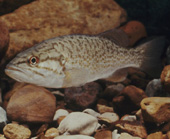Smallmouth Bass
(Micropterus dolomieu)

Smallmouth bass are native to Ohio and are found in every county of the state. They are known for their acrobatic abilities and putting up a very strong fight when caught on hook and line.
Description
Smallmouth bass have a fairly large mouth that extends to they eye but not beyond the rear edge when the mouth is closed. This characteristic distinguishes it from the largemouth bass where the back of the mouth does extend past the eye. Young smallmouth and spotted bass have an orange color in the center of their tail, juvenile largemouth bass do not. The smallmouth bass has dark vertical bars along its side with a brown or bronze colored background. Largemouth and spotted bass differ by having a black stripe that extends laterally down the side of the body and are usually lighter colored with more of a green or silvery background color.
Habitat and Habits
Smallmouth bass thrive in streams with gravel or rock bottoms with a visible current. Smallmouth bass out number largemouth bass in most streams and rivers in Ohio. In southern Ohio smallmouth are out numbered by spotted bass in some of the largest rivers such as the Muskingum, Scioto, and Ohio Rivers. Smallmouth bass are common in Lake Erie, especially around the islands and reefs of the western basin and along rocky shorelines. They are also present in the Ohio River, and are most common in tail water areas of the lock and dams where there is swift flow and rocky shorelines. They can also be found in some of Ohio's reservoirs, especially those with steep drop offs and rocky shorelines. Smallmouth bass do poorly in smaller lakes and reservoirs that are shallow, have soft substrates, and abundant aquatic vegetation.
Reproduction and Care of the Young
Smallmouth bass spawn in May and early June when water temperatures range from 55 to 65°F. Nests are built in gravel or hard bottom substrates in 2 to 20 feet of water. The female lays between 2,000 to 15,000 eggs. The male guards the nest and the fry for a short time. Young smallmouth feed on zooplankton and midge larvae.